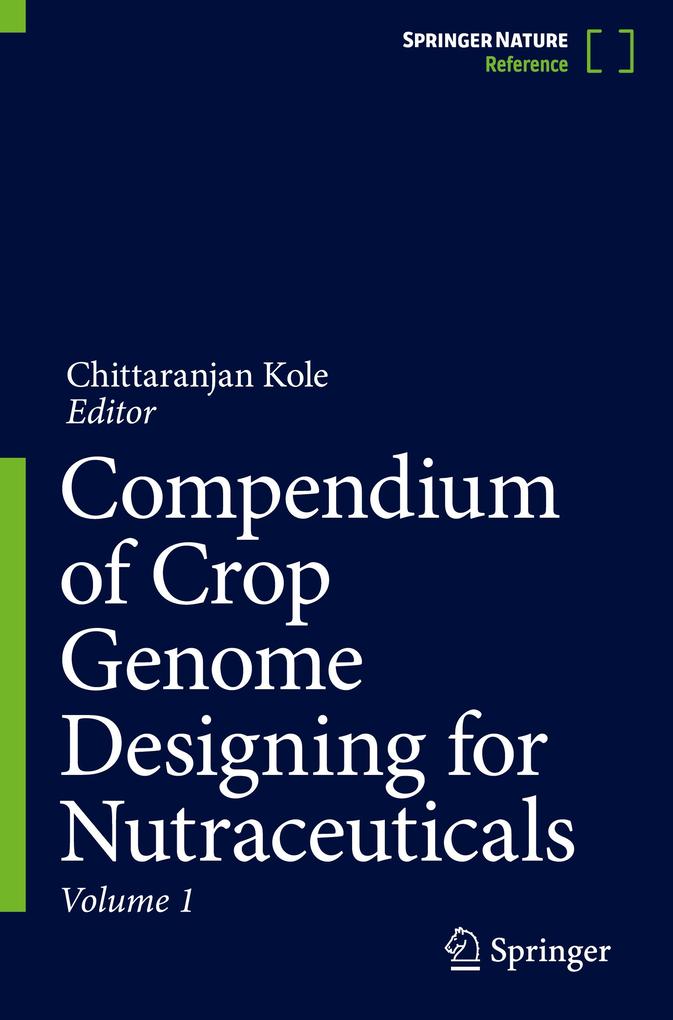
Zustellung: Mi, 21.05. - Sa, 24.05.
Versand in 1-2 Wochen
VersandkostenfreiBestellen & in Filiale abholen:
The crop plants cater not only to our basic F5 (food, feed, fiber, fuel, and furniture) needs but also provide a number of nutraceuticals with potential nutritional, safety and therapeutic properties. Many crop plants provide an array of minerals, vitamins, and antioxidant-rich bioactive phytochemicals. Increasing incidences of chronic diseases such as cancer, diabetes and HIV, and malnutrition necessitate global attention to health and nutrition security with equal emphasis to food security. This compendium compiles results of researches on biochemical, physiological and genetic mechanisms underlying biosynthesis of the health and nutrition related nutraceuticals. It also explores the precise breeding strategies for augmentation of their content and amelioration of their quality in crop plants under all commodity categories including cereals and millets, oilseeds, pulses, fruits and nuts, and vegetables. The compendium comprise 5 sections dedicated to these 5 commodity groups and presents enumeration on the concepts, strategies, tools and techniques of nutraceutomics. These sections include 50 chapters devoted to even number of major crop plants. These chapters present deliberations on the biochemistry and medicinal properties of the nutracuticals contained; genetic variation in their contents; classical genetics and breeding for their quantitative and qualitative improvement; tissue culture and genetic engineering for augmentation of productivity and quality; and sources of genes underlying their biosynthesis. They also include comprehensive enumeration on genetic mapping of the genes and QTLs controlling the contents and profile of the nutraceuticals and molecular breeding for their further improvement through marker assisted selection and backcross breeding tools. Prospects of post-genomic precise breeding strategies including genome-wide association mapping, genomic selection, allele mining, and genome editing are also discussed. This compendium fills the gap in academia, and research and development wings of the private sector industries interested in an array of subjects including genetics, genomics, tissue culture, genetic engineering, molecular breeding, genomics-assisted breeding, bioinformatics, biochemistry, physiology, pathology, entomology, pharmacognosy, IPR, etc. , and will also facilitate understanding of the policy making agencies and people in the socio-economic domain and research sponsoring agencies.
Inhaltsverzeichnis
Nutraceutical Usages and Nutrigenomics of Castor. - Genetic Enhancement of Nutraceuticals in Linseed: Breeding and Molecular Strategies. - Increasing Nutraceutical and Pharmaceutical Applications of Safflower: Genetic and Genomic Approaches. - Oil Palm: Genome Designing for Improved Nutritional Quality. - Nutritional Traits of Beans (Phaseolus vulgaris): Nutraceutical Characterization and Genomics. - Genetic Improvement of Nutraceutical Traits in Chickpea (Cicer arietinum L.). - Nutrient-Dense Pea (Pisum sativum L.): Genetics and Genomics Mediated Developments. - Breeding Cowpea: A Nutraceutical Option for Future Global Food and Nutritional Security. - Lentils (Lens culinaris Medik): Nutritional Profile and Biofortification Prospects. - Grain Micronutrients in Pigeonpea: Genetic Improvement Using Modern Breeding Approaches. - Rice Bean: A Neglected and Underutilized Food Crop Emerges as a Repertory of Micronutrients Essential for SustainableFood and Nutritional Security. - Improvement of Nutraceutical Traits of Banana: New Breeding Techniques. - Apples: Role of Nutraceutical Compounds. - Integrating Omic Tools to Design Nutraceutically Rich Citrus. - Watermelon: Advances in Genetics of Fruit Qualitative Traits. - Grapes: A Crop with High Nutraceuticals Genetic Diversity. -
Produktdetails
Erscheinungsdatum
15. Dezember 2023
Sprache
englisch
Auflage
1st edition 2023
Seitenanzahl
1704
Herausgegeben von
Chittaranjan Kole
Verlag/Hersteller
Produktart
gebunden
Abbildungen
XXXIII, 1635 p. 157 illus., 109 illus. in color. In 2 volumes, not available separately.
Gewicht
3161 g
Größe (L/B/H)
241/160/96 mm
ISBN
9789811941689
Entdecken Sie mehr
Bewertungen
0 Bewertungen
Es wurden noch keine Bewertungen abgegeben. Schreiben Sie die erste Bewertung zu "Compendium of Crop Genome Designing for Nutraceuticals" und helfen Sie damit anderen bei der Kaufentscheidung.










